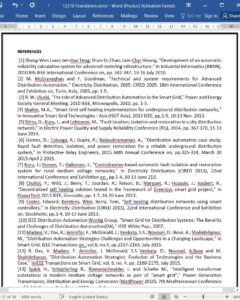Abstract
Towards the complete vision of smarter distribution grid, advanced distribution automation system (ADAS) is one of the major players in this area. In this scope, this paper introduces a generic strategy for cost-effective implementation and evaluation of ADAS. Along with the same line, fault location, isolation and service restoration (FLISR) is one of the most beneficial and desirable applications of ADAS for selfhealing and reliability improvement. Therefore, a localcentralized-based FLISR (LC-FLISR) architecture is implemented on a real, urban, underground medium voltage distribution network. For the investigated network, the complete procedure and structure of the LC-FLISR are presented. Finally, the level of reliability improvement and customers’ satisfaction enhancement are evaluated. The results are presented in the form of a comparative study between the proposed automated and non-automated distribution networks. The results show that the automated network with proposed ADAS has a considerable benefit through a significant reduction in reliability indices. In addition, it has remarkable benefits observed from increasing customers’ satisfaction and reducing penalties from industry regulators.
I. INTRODUCTION
In the contemporary world, the electrical distribution system is the backbone of the smart grid environment. However, most of customer outages are a result of the distribution networks, where 80% of customer interruptions attribute to faults and component failure at the feeder level [1]. Conventional distribution systems do not involve much automation i.e. rely mainly on manual operations, and do not have any communication or information exchange i.e. blind system. During system events, the absence of monitoring and lack of information with increasing failure rate would dramatically increase the duration and number of customers affected by specific outage. The technical impact will appear in decreasing the reliability level of the network and the quality of supply. The significant economic impact of this would be observed in increasing the outages cost of utility and their customers. For these reasons, improving system reliability and power quality becomes an important issue.
V. CONCLUSIONS
The growing importance of ADAS and its expected benefits on the operation of distribution systems encourage the investigation of this subject. The results show that the determination of the generic strategy for ADAS will avoid the huge investment toward a complete vision of smarter distribution systems. Following the proposed implemented ADAS strategy, FLISR application has been implemented on real, urban, underground 11 kV distribution network based on local-centralized architecture. From the investigation, the presented architecture is defined as a cost-effective solution with the existing network. The results of reliability analysis for both automated and non-automated distribution network are evaluated and compared. It is concluded that the automated network with the proposed ADAS has a tangible benefit through considerable reduction in load point indices. Along with the same line, the system indices such as SAIDI and EENS exhibit a significant reduction by 34 % and 32 %, respectively. In addition, the proposed ADAS provides an intangible benefits observed by grater customer satisfaction and reduced penalties by industry regulators through the reduction of the outage time and outage cost.











